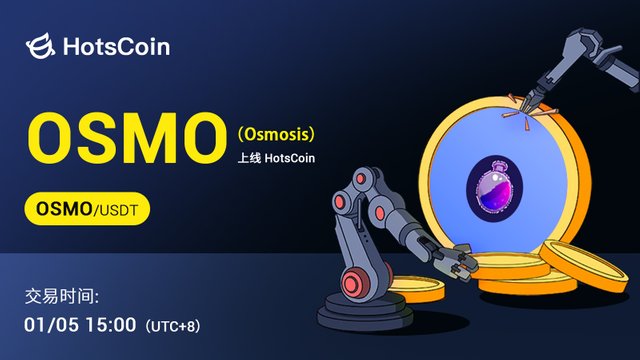
Osmosis (OSMO) was launched on HotsCoin on January 5. Osmosis is a cross-chain decentralized exchange (DEX) built in the Cosmos ecosystem as part of the sovereign Layer 1 blockchain. Currently OSMO is open for trading on HotsCoin.
1.Basic information
Osmosis is a cross-chain decentralized exchange (DEX) built in the Cosmos ecosystem as part of the sovereign Layer 1 blockchain. The platform allows developers to use a variety of modules and leverage Osmosis’ on-chain governance system to design and deploy custom automated market makers (AMMs).
Token information:
Circulation volume: 492,590,761 OSMO
Total supply: 587,378,721 OSMO
Circulation market value: $865,386,373.035
Fully diluted market capitalization: $1,756,805,936.19Key events
2021-10-28: Osmosis completes US$21 million in financing.Introduction to Osmosis
Osmosis is a DEX in the Cosmos ecosystem that supports cross-chain communication (IBC). Founded in January 2021 by Sunny Aggarwal, Josh Lee, and Dev Ojha, Osmosis is committed to building a fully customizable DEX. As part of the Cosmos Network, Osmosis aims to promote healthy markets by providing liquidity, allowing capital allocators to invest in growing projects.
How Osmosis works
Osmosis operates similarly to other AMMs by locking tokens into smart contracts and providing underlying tokens through liquidity providers (LPs). LPs are rewarded by receiving LP tokens, representing their contribution to the pool. Like traditional AMMs, Osmosis uses a deterministic pricing model to ensure that the weighting of tokens in each pool remains consistent, minimizing arbitrage opportunities.
Liquidity incentives
To ensure sufficient liquidity, Osmosis uses two mechanisms: bound liquidity indicators and exit fees. LPs will receive OSMO rewards for adding liquidity, but only mining pools determined by OSMO holders can receive rewards. Exit fees are another mechanism that charge a small fee in the form of LP tokens when LPs withdraw their funds.
Influence
Osmosis is the first DEX in the Cosmos ecosystem to support IBC, giving it a first-mover advantage. Since its launch, Osmosis has seen an upward trend in both total trading volume and total lock-up, demonstrating the market’s interest in the Cosmos ecosystem.
Protocol features
Customizable Liquidity Pools: Osmosis supports customizable pool parameters, making it a flexible market maker. This customization allows DEXs to evolve to support new features such as options markets.
Superfluid Staking: Osmosis has introduced Superfluid Staking, which uses OSMO tokens through LPs to provide liquidity while providing security to the underlying network. This model helps solve the security challenges faced by multi-chain systems.
Integrating CosmWasm: Osmosis has integrated the CosmWasm cross-chain smart contract engine, enhancing its developer ecosystem. This may lay the foundation for future supported features such as yield aggregators and liquidity management tools.
Anti-MEV: Osmosis plans to solve the maximum extractable value (MEV) problem through threshold encryption and improve fairness for DEX users.
5.OSMO Token Economics
OSMO is a native governance token that supports all functions of the Osmosis application chain. The daily epoch-based issuance will set a maximum supply of 100 million tokens and adopt a descending issuance model. 50% of the supply is airdropped to ATOM holders, and the remaining 50% is used as a strategic reserve.
6 Conclusion
As a multi-chain core DEX, Osmosis is ready to attract large amounts of liquidity and achieve protocol revenue with its flexibly set liquidity pool parameters, innovative staking model and MEV-resistant roadmap. While only time will tell of its success, early indicators show signs of success.